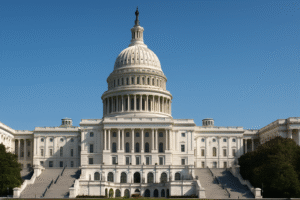Duration & Credit Pulse
Executive Summary
Bottom Line: The government shutdown beginning October 1 collided with deteriorating labor market data, creating an unprecedented policy vacuum as the September jobs report vanished and ADP showed the first employment contraction since 2023. Treasury yields fell 4-7 basis points across the curve as markets bet the Federal Reserve will be forced to ease aggressively despite missing its most critical economic indicator, while credit spreads remained frozen near historic tights—a dangerous disconnect between rates reality and credit complacency.
Duration Dashboard
| Maturity | September 28, 2025 | October 5, 2025 | Weekly Δ | 5-Year Percentile |
|---|---|---|---|---|
| 2‑Year | 3.64% | 3.58% | -7 bp | 13th %ile (low) |
| 5‑Year | 3.77% | 3.72% | -5 bp | 27th %ile (middle range) |
| 10‑Year | 4.18% | 4.12% | -6 bp | 49th %ile (middle range) |
| 30‑Year | 4.75% | 4.71% | -4 bp | 78th %ile (elevated) |
Bull Steepening Amid Data Vacuum
Curve Analysis: The yield curve exhibited classic bull steepening as front-end rates fell 7 basis points versus just 4bp at the long end, reflecting market conviction that the Fed must ease aggressively despite the data blackout. The 2s10s spread widened from 54bp to 54bp during the week, remaining relatively stable as both ends of the curve fell in tandem. The 2-year yield dropping to its 13th percentile—historically low territory that prices in multiple Fed cuts—while the 30-year bond held at the 78th percentile suggests lingering inflation concerns, creating the steepest absolute curve levels in months as recession fears trump price stability worries.
The government shutdown that began October 1 transformed what should have been a critical data week into an information void, with the Bureau of Labor Statistics furloughing approximately 2,000 employees and indefinitely postponing Friday's September employment report. Markets were left to navigate using Wednesday's catastrophic ADP print showing a 32,000 job loss—the worst reading since March 2023—while Treasury yields fell across the curve as traders bet the Fed will have no choice but to cut rates aggressively at its October 28-29 meeting despite operating without official statistics.
Credit Pulse
| Metric | September 28, 2025 | October 5, 2025 | Weekly Δ | 5-Year Percentile |
|---|---|---|---|---|
| IG OAS | 71 bp | 70 bp | -1 bp | 2nd %ile (extremely tight) |
| HY OAS | 253 bp | 256 bp | +3 bp | 2nd %ile (extremely tight) |
| VIX Index | 15.29 | 16.65 | +1.36 | 45th %ile (middle range) |
Credit markets demonstrated remarkable complacency despite accelerating macro deterioration, with investment grade spreads tightening to 70 basis points—an extraordinary 2nd percentile valuation that implies virtually no recession risk. High yield spreads widened a mere 3bp to 256bp, similarly compressed at historically tight levels despite ADP's employment contraction and the ISM Services index hitting breakeven. Yet this extreme compression has powerful technical support: taxable bond funds drew a stunning $65 billion in August inflows—the largest monthly haul since April 2021—while year-to-date corporate issuance reached $1.737 trillion, up 5.9% year-over-year. Oracle's $18 billion AI infrastructure deal priced September 24 with peak orders of $88 billion, nearly 5x oversubscribed, exemplifying insatiable demand for corporate paper regardless of macro headwinds.
The CLO market continues its record run with 2025 issuance on pace to match 2024's robust volume, supported by Moody's forecast for speculative-grade defaults to decline to just 2.6% by October versus 5.6% a year earlier. With operating margins at record highs near 31%, net leverage stable at 2.8x, and earnings growth projected at 9% for 2025, the fundamental backdrop remains constructive. Yet it's the technical bid—massive fund inflows, limited net supply after refinancings, and structural demand from banks and insurers—that keeps spreads pinned at historic tights even as the economic cycle turns.
Government Shutdown Meets Labor Market Deterioration
The week of September 28 through October 5 will be remembered as the moment America's economic data infrastructure failed precisely when markets needed it most. The government shutdown that began at 12:01 AM on October 1 didn't just inconvenience federal workers—it eliminated the flow of critical economic intelligence that guides trillion-dollar investment decisions and Federal Reserve policy. The Bureau of Labor Statistics' closure meant no September employment report, no CPI release, no producer prices—a complete blackout of official inflation and employment metrics at the most sensitive juncture for monetary policy since the 2023 banking crisis.
ADP delivers shocking employment contraction: Wednesday's ADP National Employment Report became the week's defining data point by default, and it delivered a stunning blow: private payrolls fell by 32,000 jobs in September, catastrophically missing consensus expectations of a 45,000 gain. This marked the first outright contraction in private employment since March 2023 and the worst reading in over two years. Even more concerning, August's initially reported 54,000 gain was revised to show a 3,000 loss, meaning private employment has now contracted for two consecutive months. The deterioration builds on already-weak official data showing labor market fragility. ADP Chief Economist Nela Richardson didn't mince words: "Despite strong second quarter growth, this further validates what we've been seeing—U.S. employers have been cautious with hiring."
Services sector hits stall speed: Thursday's ISM Services PMI for September provided the only other major economic release of the week, and it confirmed the deterioration: the index printed at exactly 50.0%, the precise breakeven between expansion and contraction. This reading—the weakest since January 2010 excluding the pandemic—suggests the service sector representing 90% of the U.S. economy has stalled completely. New orders fell to 48.8%, indicating contraction, while the employment index crashed to 44.1%, deep in contractionary territory. ISM Chair Steve Miller characterized the situation starkly: "Stagnation marked by weak hiring and a contraction in business activity."
Consumer confidence declines to five-month low: The Conference Board's consumer confidence index fell to 94.2 in September from 97.8 in August, marking a five-month low and missing expectations of 96.0. The Present Situation Index—consumers' assessment of current conditions—dropped 7.0 points to 125.4, the sharpest monthly decline in a year. Most troubling, the Expectations Index remained below 80 for the eighth consecutive month, a level that has historically signaled recession within 12 months. Current job availability fell for the ninth straight month while those saying jobs are "hard to get" rose to 16.7%, the highest since early 2021.
Energy markets send conflicting inflation signals: Commodity markets painted a mixed inflation picture that complicates the Fed's calculus. Crude oil continued its descent with Brent averaging around $68 per barrel and forecasts suggesting further weakness ahead—creating powerful disinflationary forces through lower transportation and input costs. Yet natural gas surged in the opposite direction, hitting $3.24/MMBtu on October 1 and showing significant strength versus 2024 levels. This divergence creates sector-specific pressures: oil producers face margin compression while gas-focused credits benefit, and consumers see relief at the pump but higher heating bills. For the Fed, collapsing oil supports the disinflation narrative while surging gas warns that energy shocks remain a wild card.
Federal Reserve Faces October Meeting Blind
The Federal Reserve enters its October 28-29 FOMC meeting in an unprecedented position: making critical policy decisions without access to two months of employment data and potentially missing September inflation metrics as well. Markets have already rendered their verdict, pricing in a 98% probability of a 25 basis point cut this month and an 87% chance of another reduction in December, but Fed officials spent the week pushing back against aggressive easing expectations despite the deteriorating data. Real yields remained remarkably anchored at 1.77% on the 10-year TIPS, implying breakeven inflation of 2.35%—still comfortably above the Fed's 2% target—suggesting the bond market sees persistent price pressures despite growth weakness.
Dallas Fed President Lorie Logan delivered the week's most hawkish commentary on September 30, warning that "there may be relatively little room to make additional rate cuts" and characterizing current policy as "likely only modestly restrictive." Her focus on non-housing services inflation running at 3.4%—"high enough to keep overall inflation above 2 percent by 30 to 40 basis points"—suggests at least some FOMC members remain more concerned about price stability than employment. Chicago Fed President Austan Goolsbee echoed this caution on October 3, describing the Fed as in "a bit of a sticky spot" and expressing wariness about "front-loading too many rate cuts." The disconnect between market pricing and Fed rhetoric grew wider as the week progressed, setting up a potentially volatile FOMC meeting.
Dollar Strength Defies Fed Easing Narrative
The Dollar Index staged a counter-intuitive rally during the week, rising over 1% to 98.19 despite deteriorating U.S. employment data and aggressive Fed easing expectations. This divergence—dollar strength amid domestic weakness—reflected a critical shift in global monetary dynamics: while markets price three Fed cuts by year-end, the European Central Bank held rates steady at 2.15% on September 11 after its own easing cycle, and the Bank of England paused at 4.0% on September 18 with UK inflation still elevated at 3.8%. The relative pause from global peers transformed traditional rate differentials, with the U.S. still offering the highest developed market yields despite its easing trajectory.
Foreign demand for Treasuries remained remarkably robust despite the shutdown chaos, with indirect bidders—primarily foreign central banks and sovereign wealth funds—capturing 66% of the week's 56-day bill auction at a 3.0x bid-to-cover ratio. This continued international appetite for U.S. assets even amid political dysfunction suggests global investors still view Treasuries as the ultimate safe haven, though conversations in Beijing, Brussels, and Basel increasingly focus on reducing dollar dependency. The dollar's year-to-date decline of 9-10% marks its steepest fall in three years, but this week's bounce amid global uncertainty hints the currency may have found a tactical floor as international alternatives remain limited.
Navigating the Void: Markets Create Their Own Reality
The government shutdown exposes critical vulnerabilities in America's market infrastructure that extend far beyond missed data releases. Credit rating agencies have repeatedly warned that political dysfunction threatens U.S. sovereign ratings—Moody's downgraded the U.S. to Aa1 in May, citing "institutional and governance strength erosion." The current shutdown validates those concerns, demonstrating that America's political system can no longer guarantee basic governmental functions like producing employment statistics. For foreign investors holding $7.8 trillion in Treasury securities, the shutdown raises uncomfortable questions about whether U.S. assets deserve their traditional safe-haven premium, though this week's continued strong foreign bid at Treasury auctions suggests no immediate alternatives exist.
Markets create feedback loops in data absence: Without official statistics, markets increasingly rely on private alternatives—ADP for employment, ISM surveys for activity, earnings calls for inflation anecdotes—creating a fragmented information landscape where narrative trumps data. This week saw that dynamic in full effect: Treasury yields fell not because official data showed weakness, but because private substitutes suggested it might exist. The danger lies in self-reinforcing cycles where market moves based on incomplete information become self-fulfilling, potentially forcing Fed action based on market expectations rather than economic reality.
The week ahead offers little clarity with the shutdown continuing indefinitely. Critical markers include FOMC minutes on October 9 that gain outsized importance given the data vacuum, weekly jobless claims as one of the few remaining real-time indicators, and multiple Fed speakers who must navigate policy communication without their primary inputs. Treasury auctions of 3-year and 10-year notes will test whether foreign demand remains resilient amid dysfunction. Most critically, the October 28-29 FOMC meeting looms with the Fed potentially making rate decisions without seeing official employment data for two consecutive months—an unprecedented policy challenge that markets are betting they'll resolve with aggressive easing.
The shutdown reality crystallizes a broader truth: America's economic machinery now operates on two levels—the official statistics that guide policy but can vanish instantly due to political theater, and the private market indicators that fill the void but provide fragmentary, often contradictory signals. This week's cross-asset divergence—stocks at records, bonds pricing recession, credit assuming perfection, the dollar strengthening despite it all—reflects this informational chaos. When different markets price completely different realities based on incomplete information, the stage is set for violent convergence once clarity returns. Whether that clarity comes from the shutdown's resolution, the Fed's October decision, or an unexpected catalyst, the current divergences suggest the resolution will be dramatic. Until then, markets navigate by instruments in heavy fog, hoping the rocks they can't see aren't dead ahead.
Key Articles of the Week
-
Government shutdown delays key monthly jobs report at pivotal momentNBC NewsOctober 3, 2025Read Article
-
US Firms Shed 32,000 Jobs in ADP Report After Data AdjustmentBloombergOctober 1, 2025Read Article
-
Treasury yields rise even after weaker-than-expected services dataCNBCOctober 3, 2025Read Article
-
Consumer confidence falls to five-month low on job concernsBloombergSeptember 30, 2025Read Article
-
Logan Says Fed Should Be Cautious With More Rate CutsBloombergSeptember 30, 2025Read Article
-
No jobs report leaves Fed flying blind. Markets still expect cutsYahoo FinanceOctober 3, 2025Read Article
-
S&P 500 closes above 6,700 for first time as traders bet on short-lived shutdownCNBCSeptember 30, 2025Read Article
-
US Service Sector Stalls: ISM Report Signals Economic WeaknessMarketMinuteOctober 3, 2025Read Article
Frequently Asked Questions
What happens to economic data during a government shutdown?
During a government shutdown, federal agencies like the Bureau of Labor Statistics furlough most employees and suspend data collection and reporting. Critical releases including employment reports, CPI inflation data, and other economic indicators are postponed indefinitely until funding resumes, leaving markets and policymakers without official statistics.
Why did Treasury yields fall despite the government shutdown October 2025?
Treasury yields dropped 4-7 basis points during the shutdown week as private employment data from ADP showed a surprising 32,000 job loss in September, the worst reading since 2023. Markets interpreted this deterioration as requiring aggressive Fed easing, driving yields lower despite the absence of official government data.
How does the Fed make policy decisions without employment data?
The Federal Reserve must rely on alternative indicators during data blackouts, including private surveys (ADP, ISM), regional Fed reports, high-frequency indicators like jobless claims, and anecdotal evidence from business contacts. However, these substitutes provide incomplete pictures, making policy decisions significantly more uncertain and potentially error-prone.
What does it mean when credit spreads are at the 2nd percentile?
Credit spreads at the 2nd percentile means they are tighter (smaller) than 98% of historical observations over the past five years. This indicates extreme complacency and minimal risk premium, suggesting investors see virtually no default risk despite economic deterioration—a potentially dangerous disconnect that often precedes market corrections.







